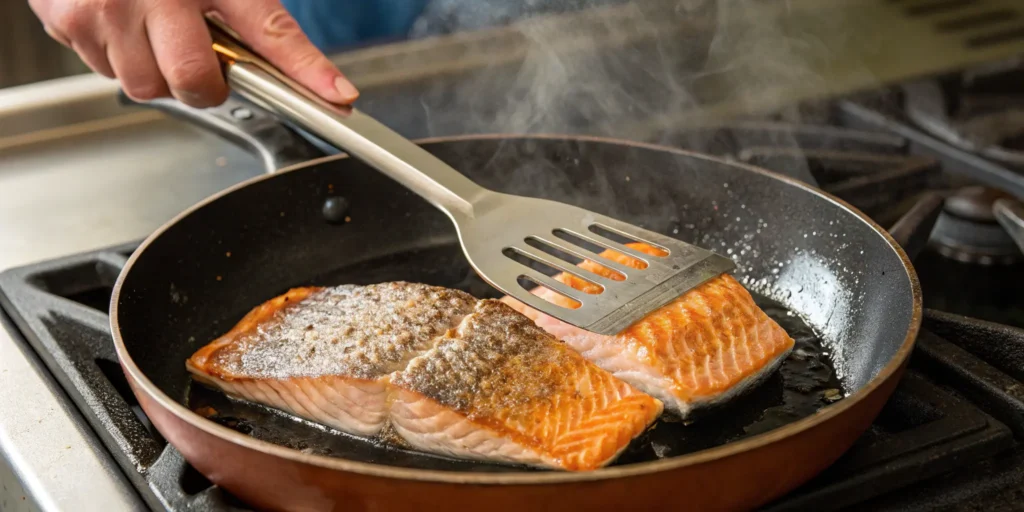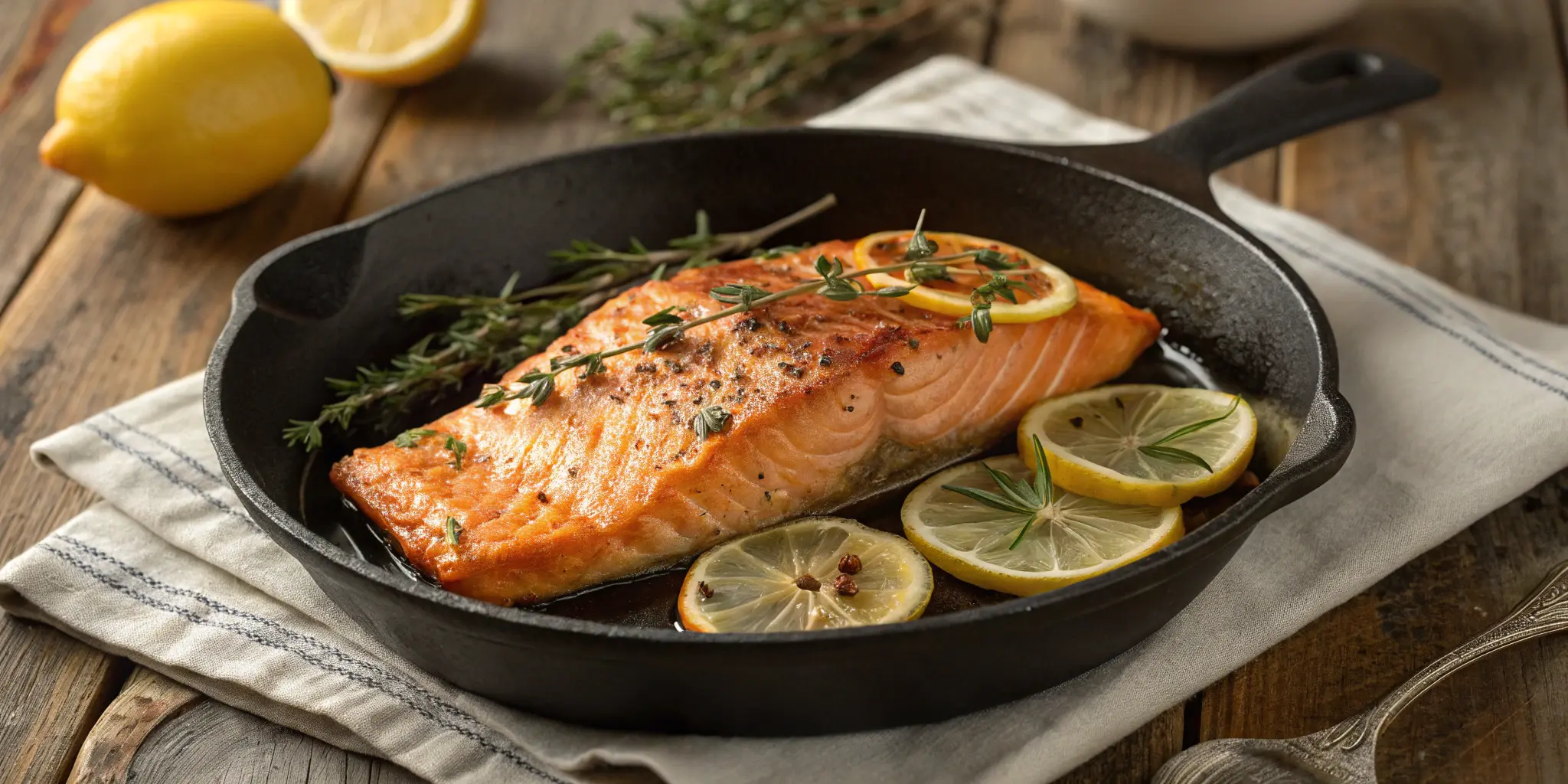Pan Fried Salmon: 3 Simple Tricks for Perfect Crispiness
Table of Contents
Remember the First Time You Tried Pan Fried Salmon?
If you’re like most home cooks, you’ve probably tried to make pan fried salmon at least once. You had high hopes for a crisp, golden skin and moist, flaky inside—but ended up with soggy skin and uneven texture. Don’t worry, you’re not alone. The good news? With just a few smart techniques, you can turn that disappointment into a new go-to dish that’s as impressive as anything you’d order at a high-end seafood restaurant.
Crisping salmon isn’t about fancy ingredients or high-end equipment—it’s about knowing what makes the difference. Here, you’ll learn the top three tricks that transform your pan fried salmon from average to amazing.
Why Crispiness Matters in Pan Fried Salmon
Crispy skin isn’t just for looks. It adds:
- A Satisfying Texture: That contrast between crunchy skin and juicy flesh creates a mouthfeel that keeps you coming back for more.
- Flavor Depth: The Maillard reaction (when proteins brown under high heat) adds savory notes you just can’t get with steaming or baking alone.
- Nutritional Benefits: Salmon skin contains collagen, omega-3 fatty acids, and nutrients that support heart and skin health.
Mastering crispiness means you’re getting more taste, texture, and nutrition all in one bite.
Gear & Ingredients You Need
Before diving into the tricks, make sure you’re equipped to do the job right.
Essential Tools
- Non-stick or Stainless Steel Skillet: Avoid cast iron for this task unless it’s very well seasoned.
- Fish Spatula: Flexible enough to glide under delicate skin without tearing it.
- Paper Towels: For drying the skin thoroughly.
- Instant Read Thermometer (Optional): Ensures precision.
Ingredient Table

| Ingredient | Amount | Purpose |
|---|---|---|
| Salmon fillets (skin-on) | 2-4 pieces | Main protein |
| Sea salt | To taste | Draws out moisture, enhances flavor |
| Black pepper | To taste | Adds heat and aroma |
| Oil (high smoke point) | 2 tbsp | Ensures proper sear |
| Butter (optional) | 1 tbsp | Flavor boost and richness |
| Fresh herbs (optional garnish) | As needed | Visual and aromatic finish |
Trick #1: Pat the Skin Completely Dry
One of the biggest reasons salmon skin doesn’t crisp is moisture. If the skin is wet, it will steam, not sear.

How to Do It Right:
- Lay the fillets skin-side up on a paper towel.
- Press another towel firmly on top.
- If you’re prepping in advance, leave them uncovered in the fridge for 30 minutes to air-dry.
- Salt the skin side after drying.
Why it Works: Removing surface moisture allows the hot oil to contact the skin directly, encouraging an even golden crust.
Extra Tip: Some chefs use a fan or a blow dryer on a cool setting to speed up drying.
Trick #2: Preheat Your Pan Thoroughly
The pan should be hot enough to sizzle the second the fish hits it. This is where many home cooks mess up.

Getting the Pan Ready:
- Heat your pan on medium-high for 2–3 minutes.
- Add oil and tilt the pan to coat evenly.
- Watch for shimmering oil or the faint hint of smoke.
Test: Flick a drop of water—if it dances and evaporates instantly, your pan is ready.
Why It Matters:
- Cold pans steam the fish, making the skin soggy.
- A hot pan forms a crust quickly, sealing in juices and flavor.
The Searing Process:
- Gently lay the fillet away from you, skin-side down.
- Do not move it. Let it form a crust.
Let the pan do the work. Your only job is to wait.
Trick #3: Press and Then Leave It Alone
As soon as the fish touches the pan, it naturally curls. That curl prevents the entire surface from contacting the heat.

Here’s What to Do:
- Use a spatula to press the fillet flat for the first 30 seconds.
- Apply gentle, even pressure.
- After that, hands off! Let it cook untouched.
Cooking Times Based on Thickness:
| Thickness | Skin-Side Time | Flesh-Side Time |
| 1 inch | 5–6 minutes | 1–2 minutes |
| 1.5 inches | 6–7 minutes | 2–3 minutes |
Cook skin-side down for 90% of the total time. This keeps the flesh juicy while crisping the skin perfectly.
Bonus Tips for Restaurant-Level Results
Want to really impress? These small changes go a long way:
- Add a pat of butter and fresh herbs in the final 30 seconds.
- Deglaze the pan with lemon juice or white wine for instant sauce.
- Rest the salmon skin-side up to avoid trapping steam.
- Use flaky sea salt at the end for added texture.
Common Mistakes to Avoid
Avoid these rookie errors if you want a crisp-skinned success story:
- Cooking the salmon cold straight from the fridge.
- Using low-smoke point oils like olive oil.
- Moving the fish around too much.
- Overcrowding the pan, which drops the temperature.
- Not patting the skin completely dry.
What to Serve With Pan Fried Salmon
Crispy salmon pairs beautifully with both light and hearty sides. Here are some fan favorites:
Vegetable Sides
- Garlic butter asparagus
- Sauteed spinach with lemon zest
- Roasted broccoli or Brussels sprouts
Starches
- Lemon herb rice
- Creamy mashed potatoes
- Quinoa with pine nuts
Sauces
- Dill yogurt sauce
- Lemon caper pan sauce
- Honey mustard glaze
Mix and match to suit your taste or occasion.
FAQ: Everything You Need to Know About Pan Fried Salmon
What’s the best oil for pan frying salmon?
Use oils with a high smoke point, like avocado, canola, grapeseed, or sunflower oil.
Should I remove the skin before frying?
No—the skin acts as a protective barrier. It crisps up beautifully and keeps the flesh moist.
How do I prevent salmon from sticking to the pan?
Make sure the pan is fully preheated and the skin is dry. Also, let the salmon release naturally without forcing it.
Can I pan fry frozen salmon?
Thaw it completely first. Moisture from frozen salmon will steam the fish and prevent crisping.
How can I tell when salmon is done?
The flesh should flake easily and appear opaque. An internal temperature of 125°F to 130°F is ideal for medium doneness.
Final Thoughts: You’ve Got This
Perfecting pan fried salmon isn’t a mystery. It’s a matter of understanding the small details that make a big difference. Dry the skin, heat the pan, press it down, and then let it crisp in peace. Follow these three core tricks, and you’ll be plating up restaurant-level salmon from your own kitchen in no time.
Whether you’re cooking for family, friends, or just yourself, a perfectly seared salmon fillet sends the message: “I know what I’m doing.”
Now it’s your turn:
Try these techniques tonight and tag your crispy salmon masterpiece on social media with #PanFriedPerfection. Trust us, your followers will want the recipe.
Ready to elevate your cooking game? Bookmark this guide and make every salmon night a win.

